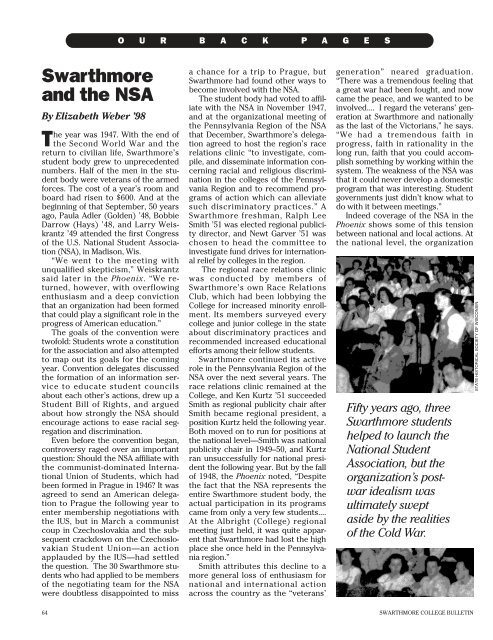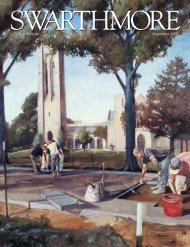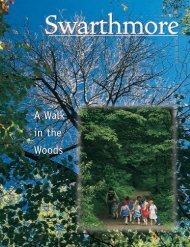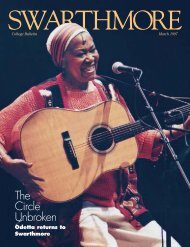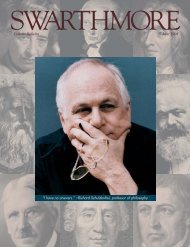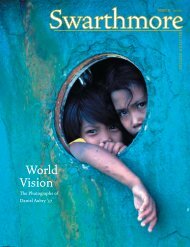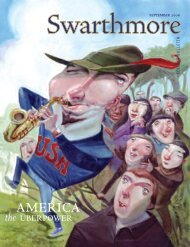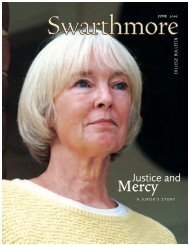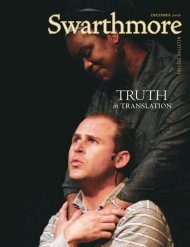September 1997 - Swarthmore College :: ITS
September 1997 - Swarthmore College :: ITS
September 1997 - Swarthmore College :: ITS
You also want an ePaper? Increase the reach of your titles
YUMPU automatically turns print PDFs into web optimized ePapers that Google loves.
<strong>Swarthmore</strong><br />
and the NSA<br />
By Elizabeth Weber ’98<br />
The year was 1947. With the end of<br />
the Second World War and the<br />
return to civilian life, <strong>Swarthmore</strong>’s<br />
student body grew to unprecedented<br />
numbers. Half of the men in the student<br />
body were veterans of the armed<br />
forces. The cost of a year’s room and<br />
board had risen to $600. And at the<br />
beginning of that <strong>September</strong>, 50 years<br />
ago, Paula Adler (Golden) ’48, Bobbie<br />
Darrow (Hays) ’48, and Larry Weiskrantz<br />
’49 attended the first Congress<br />
of the U.S. National Student Association<br />
(NSA), in Madison, Wis.<br />
“We went to the meeting with<br />
unqualified skepticism,” Weiskrantz<br />
said later in the Phoenix. “We returned,<br />
however, with overflowing<br />
enthusiasm and a deep conviction<br />
that an organization had been formed<br />
that could play a significant role in the<br />
progress of American education.”<br />
The goals of the convention were<br />
twofold: Students wrote a constitution<br />
for the association and also attempted<br />
to map out its goals for the coming<br />
year. Convention delegates discussed<br />
the formation of an information service<br />
to educate student councils<br />
about each other’s actions, drew up a<br />
Student Bill of Rights, and argued<br />
about how strongly the NSA should<br />
encourage actions to ease racial segregation<br />
and discrimination.<br />
Even before the convention began,<br />
controversy raged over an important<br />
question: Should the NSA affiliate with<br />
the communist-dominated International<br />
Union of Students, which had<br />
been formed in Prague in 1946? It was<br />
agreed to send an American delegation<br />
to Prague the following year to<br />
enter membership negotiations with<br />
the IUS, but in March a communist<br />
coup in Czechoslovakia and the subsequent<br />
crackdown on the Czechoslovakian<br />
Student Union—an action<br />
applauded by the IUS—had settled<br />
the question. The 30 <strong>Swarthmore</strong> students<br />
who had applied to be members<br />
of the negotiating team for the NSA<br />
were doubtless disappointed to miss<br />
O U R B A C K P A G E S<br />
a chance for a trip to Prague, but<br />
<strong>Swarthmore</strong> had found other ways to<br />
become involved with the NSA.<br />
The student body had voted to affiliate<br />
with the NSA in November 1947,<br />
and at the organizational meeting of<br />
the Pennsylvania Region of the NSA<br />
that December, <strong>Swarthmore</strong>’s delegation<br />
agreed to host the region’s race<br />
relations clinic “to investigate, compile,<br />
and disseminate information concerning<br />
racial and religious discrimination<br />
in the colleges of the Pennsylvania<br />
Region and to recommend programs<br />
of action which can alleviate<br />
such discriminatory practices.” A<br />
<strong>Swarthmore</strong> freshman, Ralph Lee<br />
Smith ’51 was elected regional publicity<br />
director, and Newt Garver ’51 was<br />
chosen to head the committee to<br />
investigate fund drives for international<br />
relief by colleges in the region.<br />
The regional race relations clinic<br />
was conducted by members of<br />
<strong>Swarthmore</strong>’s own Race Relations<br />
Club, which had been lobbying the<br />
<strong>College</strong> for increased minority enrollment.<br />
Its members surveyed every<br />
college and junior college in the state<br />
about discriminatory practices and<br />
recommended increased educational<br />
efforts among their fellow students.<br />
<strong>Swarthmore</strong> continued its active<br />
role in the Pennsylvania Region of the<br />
NSA over the next several years. The<br />
race relations clinic remained at the<br />
<strong>College</strong>, and Ken Kurtz ’51 succeeded<br />
Smith as regional publicity chair after<br />
Smith became regional president, a<br />
position Kurtz held the following year.<br />
Both moved on to run for positions at<br />
the national level—Smith was national<br />
publicity chair in 1949–50, and Kurtz<br />
ran unsuccessfully for national president<br />
the following year. But by the fall<br />
of 1948, the Phoenix noted, “Despite<br />
the fact that the NSA represents the<br />
entire <strong>Swarthmore</strong> student body, the<br />
actual participation in its programs<br />
came from only a very few students....<br />
At the Albright (<strong>College</strong>) regional<br />
meeting just held, it was quite apparent<br />
that <strong>Swarthmore</strong> had lost the high<br />
place she once held in the Pennsylvania<br />
region.”<br />
Smith attributes this decline to a<br />
more general loss of enthusiasm for<br />
national and international action<br />
across the country as the “veterans’<br />
generation” neared graduation.<br />
“There was a tremendous feeling that<br />
a great war had been fought, and now<br />
came the peace, and we wanted to be<br />
involved.... I regard the veterans’ generation<br />
at <strong>Swarthmore</strong> and nationally<br />
as the last of the Victorians,” he says.<br />
“We had a tremendous faith in<br />
progress, faith in rationality in the<br />
long run, faith that you could accomplish<br />
something by working within the<br />
system. The weakness of the NSA was<br />
that it could never develop a domestic<br />
program that was interesting. Student<br />
governments just didn’t know what to<br />
do with it between meetings.”<br />
Indeed coverage of the NSA in the<br />
Phoenix shows some of this tension<br />
between national and local actions. At<br />
the national level, the organization<br />
Fifty years ago, three<br />
<strong>Swarthmore</strong> students<br />
helped to launch the<br />
National Student<br />
Association, but the<br />
organization’s postwar<br />
idealism was<br />
ultimately swept<br />
aside by the realities<br />
of the Cold War.<br />
64 SWARTHMORE COLLEGE BULLETIN<br />
STATE HISTORICAL SOCIETY OF WISCONSIN


